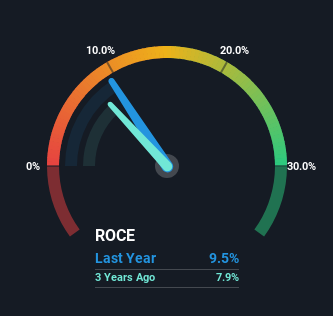- Hong Kong
- /
- Hospitality
- /
- SEHK:3918
Returns On Capital Signal Difficult Times Ahead For NagaCorp (HKG:3918)

When it comes to investing, there are some useful financial metrics that can warn us when a business is potentially in trouble. Businesses in decline often have two underlying trends, firstly, a declining return on capital employed (ROCE) and a declining base of capital employed. This indicates the company is producing less profit from its investments and its total assets are decreasing. Having said that, after a brief look, NagaCorp (HKG:3918) we aren't filled with optimism, but let's investigate further.
Return On Capital Employed (ROCE): What Is It?
If you haven't worked with ROCE before, it measures the 'return' (pre-tax profit) a company generates from capital employed in its business. The formula for this calculation on NagaCorp is:
Return on Capital Employed = Earnings Before Interest and Tax (EBIT) ÷ (Total Assets - Current Liabilities)
0.095 = US$199m ÷ (US$2.8b - US$653m) (Based on the trailing twelve months to December 2023).
So, NagaCorp has an ROCE of 9.5%. On its own that's a low return, but compared to the average of 4.6% generated by the Hospitality industry, it's much better.
View our latest analysis for NagaCorp

In the above chart we have measured NagaCorp's prior ROCE against its prior performance, but the future is arguably more important. If you'd like to see what analysts are forecasting going forward, you should check out our free analyst report for NagaCorp .
The Trend Of ROCE
In terms of NagaCorp's historical ROCE movements, the trend doesn't inspire confidence. About five years ago, returns on capital were 22%, however they're now substantially lower than that as we saw above. And on the capital employed front, the business is utilizing roughly the same amount of capital as it was back then. This combination can be indicative of a mature business that still has areas to deploy capital, but the returns received aren't as high due potentially to new competition or smaller margins. So because these trends aren't typically conducive to creating a multi-bagger, we wouldn't hold our breath on NagaCorp becoming one if things continue as they have.
While on the subject, we noticed that the ratio of current liabilities to total assets has risen to 24%, which has impacted the ROCE. Without this increase, it's likely that ROCE would be even lower than 9.5%. While the ratio isn't currently too high, it's worth keeping an eye on this because if it gets particularly high, the business could then face some new elements of risk.
The Bottom Line
All in all, the lower returns from the same amount of capital employed aren't exactly signs of a compounding machine. Long term shareholders who've owned the stock over the last five years have experienced a 62% depreciation in their investment, so it appears the market might not like these trends either. Unless there is a shift to a more positive trajectory in these metrics, we would look elsewhere.
If you're still interested in NagaCorp it's worth checking out our FREE intrinsic value approximation for 3918 to see if it's trading at an attractive price in other respects.
While NagaCorp may not currently earn the highest returns, we've compiled a list of companies that currently earn more than 25% return on equity. Check out this free list here.
Valuation is complex, but we're here to simplify it.
Discover if NagaCorp might be undervalued or overvalued with our detailed analysis, featuring fair value estimates, potential risks, dividends, insider trades, and its financial condition.
Access Free AnalysisHave feedback on this article? Concerned about the content? Get in touch with us directly. Alternatively, email editorial-team (at) simplywallst.com.
This article by Simply Wall St is general in nature. We provide commentary based on historical data and analyst forecasts only using an unbiased methodology and our articles are not intended to be financial advice. It does not constitute a recommendation to buy or sell any stock, and does not take account of your objectives, or your financial situation. We aim to bring you long-term focused analysis driven by fundamental data. Note that our analysis may not factor in the latest price-sensitive company announcements or qualitative material. Simply Wall St has no position in any stocks mentioned.
About SEHK:3918
NagaCorp
An investment holding company, engages in the management and operation of hotel and casino complex in the Kingdom of Cambodia.
Excellent balance sheet with moderate growth potential.
Market Insights
Community Narratives



